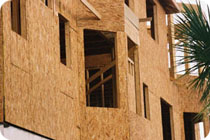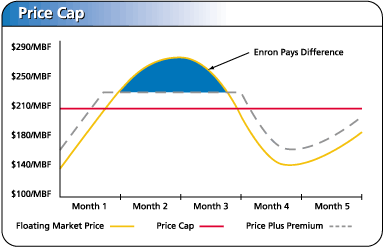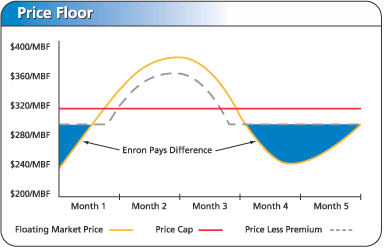 |
 Price swaps are typically used to fully convert from one price
exposure to another - from floating to fixed, for example. Like
swaps, caps and floors provide price protection, but they have
the added advantage of providing benefit from favorable price
movements. They are commonly thought of as a "price guarantee"
in that, for a premium, you are entitled to full price protection
when prices move past a specified level. A price cap protects
against rising prices without sacrificing the benefit from falling
prices. Floors are the opposite of caps: they protect against
falling prices but retain upside potential should prices increase.
When a customer buys a price cap or floor, the full cost of the
protection is predefined - it is equal to the premium paid for
the cap or floor. There are no potential future costs related to
price movements.
Price swaps are typically used to fully convert from one price
exposure to another - from floating to fixed, for example. Like
swaps, caps and floors provide price protection, but they have
the added advantage of providing benefit from favorable price
movements. They are commonly thought of as a "price guarantee"
in that, for a premium, you are entitled to full price protection
when prices move past a specified level. A price cap protects
against rising prices without sacrificing the benefit from falling
prices. Floors are the opposite of caps: they protect against
falling prices but retain upside potential should prices increase.
When a customer buys a price cap or floor, the full cost of the
protection is predefined - it is equal to the premium paid for
the cap or floor. There are no potential future costs related to
price movements.
How Panel Co. Uses a Cap to Attract and Land New Business
Panel Co., a large OSB Wholesaler, wants to develop a business with
a prospect that has difficulty passing on price increases but is
expected to pass on decreases without delay.
To distinguish itself from competitors, Panel Co. ensures the
prospect that for the next year Panel Co. will never ask for an
OSB price increase above its competitive product prices no matter
how high OSB prices go. And to sweeten the deal, Panel Co. agrees
to promptly pass on all the OSB price decreases as soon as they
are announced, no questions asked.
The prospect likes Panel Co.'s straightforward pricing policy and
agrees to purchase 2 MMSF of OSB per month. In order to honor their
pricing without putting the company's margins at risk to rising
prices, Panel Co. purchases a 1-year price cap on OSB at $210/MSF.
The cost of the cap is $20/MSF.
During the Life of the Cap Agreement
- Panel Co. continues to buy OSB from its regular suppliers at market prices.
- Enron receives an up-front payment of $20/MSF from Panel Co. for the $210 price cap.
- If the market price for OSB goes above $210 in a given month,
Enron will pay the difference to Panel Co. If prices are less
than $210, Panel Co. enjoys the lower market prices for their
raw materials.
- Panel Co. has, for a known cost, captured business by meeting the
customer's price needs without putting the company at risk to OSB
prices in the process.

The price cap protects the consumer from price increases but enables full
participation in price decreases.
|
Smart Use of Floor Protects Lumber Company During Plant Downtime
Lumber Co., a producer of 2x4 southern yellow pine, anticipates a plant
turn-around in three months' time and lasting for two months, during which
time the plant will be taken off-line. The company intends to build extra
2x4 southern yellow pine inventory of 80 MMBF over the next three months
to meet sales obligations during the two-month shutdown. There is concern
that prices could soften over the next three months, squeezing the margin
on the excess inventory to be sold during that time.
To protect against a sharp price reduction during the turn-around period,
Lumber Co. buys a two-month 2x4 southern yellow pine price floor today that
becomes effective in three months' time. The floor price is set at $320/MBF
and costs $20/MSF. The total premium payable by Lumber Co. is $1.6 million
(80,000 x $20/MSF).
Each Month During the Life of the Price Floor
- Lumber Co. sells excess 2x4 southern yellow pine inventory to their
customers at prevailing market (floating) prices.
- Enron receives an up-front $20/MSF premium from Lumber Co. for the $320/MBF price floor.
- If the floating price for 2x4 southern yellow pine is greater than
the $320/MBF floor price, there is no action under the floor contract.
The effective price received by Lumber Co. for their 2x4 southern
yellow pine is the floating market price less the premium.
- If the floating price goes below the $320/MBF floor price, $290/MSF
for example, Lumber Co. will receive the difference of $30 from
Enron. In this instance, Lumber Co.'s effective price for 2x4
southern yellow pine is $300/MBF - the $320/MBF floor price less the
$20 premium for the first month.
In summary, the price floor has established a minimum price of $320/MBF with
a full upside potential at a known cost of $20/MBF.

The price floor protects the producer from price decreases but enables full
participation in price increases.
|
Disclaimer
 |





